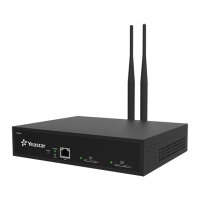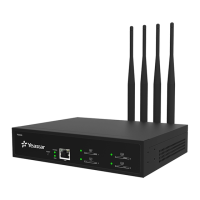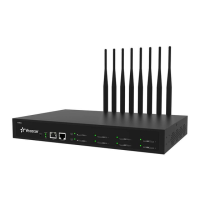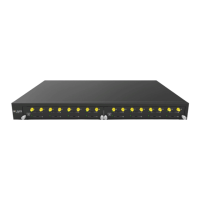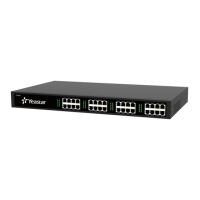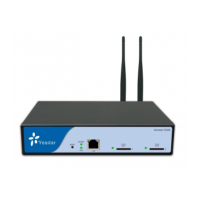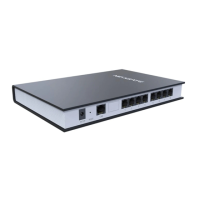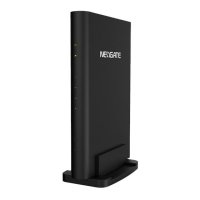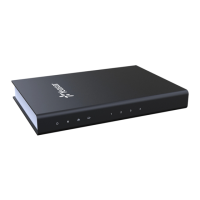Do you have a question about the Yeastar Technology NeoGate TG800 and is the answer not in the manual?
| Product Type | GSM Gateway |
|---|---|
| GSM Channels | 8 |
| Frequency | 850/900/1800/1900 MHz |
| SMS | Supported |
| SIM Slots | 8 |
| Power Supply | AC 100-240V, 50/60Hz |
| Storage Temperature | -20°C to 70°C |
| Certifications | CE, FCC, RoHS |
| Protocols | SIP |
| Voice Codecs | G.711, G.729, G.726, GSM |
| Echo Cancellation | G.168 |
| Transport Protocols | TCP, UDP |
| Operating Temperature | 0°C to 40°C |
| Humidity | 10% to 90% (non-condensing) |
Details the main functionalities and capabilities of the NeoGate TG Gateway, including SIP proxy and SMS features.
Provides a detailed overview of the hardware specifications for different NeoGate TG models.
Step-by-step instructions for correctly inserting the SIM card into the NeoGate device.
Guidance on connecting the external antenna for optimal wireless signal reception.
Instructions for establishing a wired network connection using Ethernet cables.
Procedure for connecting the NeoGate unit to a power source.
Details on accessing the device's web interface for the first time using default credentials.
Provides an overview of the system's operational status, including trunk and network health.
Displays the current status of GSM and VoIP trunks, indicating availability and usage.
Shows the IP address, subnet mask, and gateway for the LAN port.
Displays hardware version, firmware version, and disk/memory usage statistics.
Access and analyze detailed records of all calls made and received through the gateway.
Allows downloading and deleting system logs for troubleshooting and debugging purposes.
Settings for network interface, DNS, and hostnames.
Configuration options for the Local Area Network interface, including IP address and DHCP.
Setup for Virtual Local Area Networks to segment network traffic.
Configuration for establishing secure Virtual Private Network connections.
Setup for Dynamic DNS to enable access via a domain name.
Defining specific paths for network traffic when multiple gateways are present.
Centralized access point for all security-related configurations and settings.
Creating and managing firewall rules to protect the device from unauthorized access.
Setting up rules to automatically block IP addresses based on packet rate.
Configuration of core system parameters like password, date, time, and updates.
Procedure for changing the administrator account password for enhanced security.
Setting and synchronizing the system's date and time, including time zone.
Allows uploading and managing custom audio prompts for system use.
Configuring email alerts for system events and voicemail notifications.
Instructions for upgrading the device's firmware to the latest version.
Methods for backing up current settings and restoring them later.
Procedures for rebooting the system or resetting it to factory default settings.
Guide on composing and sending SMS messages via the gateway's GSM ports.
Adding, editing, and organizing contacts for SMS communication.
View the history of sent SMS messages, including status and delivery information.
Access and manage incoming SMS messages, with options to search and reply.
Utilizing Unstructured Supplementary Service Data for carrier-specific services.
Configuration for programmatic access to SMS and USSD functionalities.
Overview and management of all connected GSM, UTMTS, and CDMA ports.
Detailed configuration for each GSM/UTMTS/CDMA channel, including gains and tones.
Organizing mobile channels into groups for efficient call routing strategies.
Enabling and configuring the call waiting feature for incoming calls.
Setting up the 'Follow Me' feature to forward calls to another number.
Setting up Voice over IP trunks, including SIP and IAX accounts and providers.
Creating and managing groups of VoIP trunks for organized call routing.
Detailed configuration for SIP protocol, including General, NAT, Codecs, QoS, and Advanced options.
Settings for the Internal Asterisk Exchange protocol, including ports and codecs.
Global settings for VoIP features like ring timeout and maximum call duration.
Configuring rules to route calls from GSM/UTMTS/CDMA channels to IPPBX.
Configuring rules to route calls from VoIP trunks to GSM/UTMTS/CDMA channels.
Blocking specific incoming or outgoing calls by adding numbers to a blacklist.
Configuring the callback feature to automatically call back users after they hang up.
Illustrates a common application scenario involving SIP phones, LAN, and GSM.
Depicts another application scenario with IPPBX, softphones, and GSM connections.
